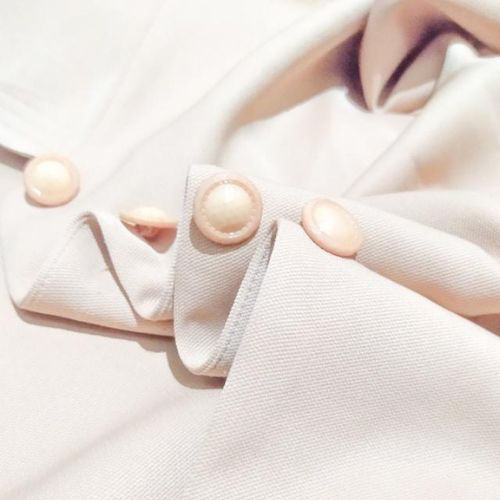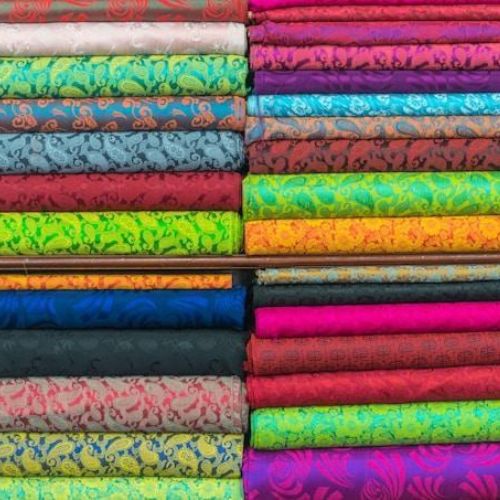Identifying non-vegan materials in clothing can be tricky, especially in inconspicuous parts. It’s easy to miss out on animal-derived fabric treatments, adhesives, or buttons.
Let’s dive into the world of vegan fashion and learn how to identify clothing that’s as kind to animals as it is to your style.
#1 Suede

A type of leather, suede is made from the underside of animal hides, typically from lamb, goats, pigs, calves and deer. Making suede involves sanding or buffing the inner surface of the hide to create a soft, napped finish. This gives suede its characteristic texture and appearance.
Thankfully, suede leather has a wide range of vegan-friendly, cruelty-free alternatives. The best part? You still get the same soft suede feel and aesthetics. These include synthetic fibre microfiber suede, polyester faux suede and recycled polyester suede.
Unique vegan-friendly suede alternatives include branded polyester and polyurethane Alcantara suede, cork (made from coak oak barks) and mushroom (from mushroom mycelium) suede.
#2 Wool

The wool industry’s fluffy facade hides a prickly truth that’ll have you thinking twice about that cosy jumper. But don’t despair, as there are oodles of warm, wool-free fabrics to opt for, such as hemp wool, Tencel and organically sourced cotton.
#3 Silk

For silk, it’s not all smooth sailing. This luxurious fabric comes at a cost more tangled than the cocoons of Bombyx mori moths from which it’s harvested. The raw truth? Silk extraction is cruel. These moths are boiled alive and their silk glands are then woven into the thread.
But before you swear off silk, take heart in the vegan society’s treasure trove of non-vegan material swaps. Choose anything from peace silk or bamboo silk to other vegan-friendly alternatives.
#4 Fur

Fur may hark back to caveman chic, but in the modern world, it’s often synonymous with cruel practices. The good news? Faux fur is making a fabulous, guilt-free splash on the scene, allowing you to strut your stuff without harm.
Learning to distinguish between real and faux fur means you can embrace the luxe look and feel while keeping your conscience as clear as a polished diamond.
#5 Down Feathers

Gone are the days when down feathers were the only ticket to toasty town. Vegan-friendly options now offer the same snuggle-factor, minus the cruelty. Synthetic down fibres that let you sleep like a baby, knowing no birds were harmed for your comfort.
#6 Leather

Leather may have a ‘cool’ reputation, but its connection to the meat industry is a hot topic for the eco-conscious. Thankfully, animal lovers can rejoice in the rise of faux and vegan leather or recycled polyester, proving that style and compassion can coexist.
#7 Lanolin

A natural wax, lanolin, is extracted from the sebaceous glands of wool-bearing animals, particularly sheep. Lanolin is primarily used as an emulsifying agent in cosmetics and pharmaceuticals. However, its versatility allows it to act as a water and dust-repellent coating in clothing.
Unfortunately, it’s not easy to pick out clothing that uses lanolin if not disclosed. So, you may have to do the extra heavy lifting and research your retailer. Lanolin, whether used in cosmetics or clothing, has plant-based or synthetic vegan-friendly alternatives.
These include Brazilian-plant-based candelilla wax, carnauba wax, or silicone-based wax. These alternatives are typically melted and applied to woollen garments when used for water and dirt-repelling functions.
#8 Animal-Derived Glue

Hidden animal derivatives are the ninjas of the clothing world — silent, stealthy and not on our watch. Those stylish shoes might have a sticky secret – animal-derived glue. Bone, skin and milk protein casein are the usual suspects.
But don’t get stuck in despair, for there are plenty of compassionate adhesives to keep your conscience as clean as your kicks.
#9 Buttons, Zippers and Embellishments Sourced from Animals

While you might be well-versed in the obvious offenders, hidden animal products in clothing are the sneakiest of them all. Buttons made from horn and bone, zippers and shiny embellishments often come at an animal’s expense.
However, with a keen eye for detail and a heart for animals, you can choose alternatives that are just as stylish without the ethical compromise.
Suggested read: The Little-Known Skincare Ingredients That Aren’t Vegan
#10 Animal-Based Dyes

Even the colours on your fabric may have a dark side, with animal-based dyes hiding in plain sight. But fear not, as the rainbow of vegan options is just as vibrant and infinitely more kind-hearted.
By opting for plant-based hues, you’ll be painting a picture of a future where fashion is both stunning and sustainable.
#11 Waxed Jackets

Waxed jackets may fend off the rain, but can they shield against hidden animal products? When beeswax is in the mix, your vegan radar should be buzzing. Luckily, outerwear brands are beginning to embrace paraffin-based alternatives.
Opting for Plant-Based and Synthetic Alternatives
Gone are the days when cotton was the only plant-based option for your wardrobe. Today, innovations in fashion have introduced us to materials like hemp and linen, which are as durable as they are eco-friendly.
The cotton plant, a vegan staple, now shares the spotlight with these robust fabrics that grow without the need for harmful pesticides, offering a guilt-free choice for your clothing.
Popular Vegan Materials in Ethical Fashion to Try Out
When you’re on the hunt for ethical fashion, keep an eye out for vegan leather, cotton, hemp and bamboo. These alternatives not only spare animal lives. They also offer versatility, breathability, comfort and flair to your outfit.
Polyester fleece and tencel bring softness to your closet, while faux fur adds a touch of luxury without the guilt. Vegan shoes made from microfibre, pineapple leather and other innovative materials are stepping up the game.
Fortunately, many vegan fabrics are low-maintenance and durable. Follow care labels closely, opt for eco-friendly detergents and embrace gentle washing methods to keep your garments in pristine condition, ensuring longevity and sustainability.
Look for Trusted Certificates and Seals for Vegan Clothing
Confidently fill your wardrobe with compassion by looking for trusted certificates and seals. These endorsements guarantee that no animal materials were used in the manufacturing process and that label shoes and other items are indeed vegan.
They serve as a beacon of trust for consumers seeking to support ethical practices in the fashion industry.
Learn How to Read Clothing Labels
Material labels are your crystal ball when shopping for clothes. They reveal the secrets behind vegan-friendly clothing and expose non-vegan clothing like a magician’s trick gone wrong.
Fashion brands are joining the vegan clothing brands convoy, so keep those eyes peeled for vegan clothing materials!
Engage With Brands to Encourage Ethical Practices
Encouraging ethical practices goes beyond personal shopping habits. Engage with fashion brands, asking about their synthetic material use and their stance on animal welfare.
Your voice can influence their policies, nudging them towards more compassionate choices and ensuring a brighter future for fashion.
Embracing Vegan-Friendly Clothing
Adopting a wardrobe that respects animal welfare is more than a trend; it’s a commitment to a kinder world. By choosing not to wear animal cruelty products, you take a stand against cruelty. Your wardrobe is a statement of your beliefs.
You’re advocating for change. Every vegan garment purchased is a vote for compassion. Each vote pushes the industry towards more ethical and sustainable vegan fabrics.

It’s great to see how fashion can evolve without harming animals. Any recommendations on where to find such sustainable fashion items?
is there any tech that helps identify vegan materials easily? gets tricky sometimes knowing what’s truly vegan.
There are apps in development aimed at making it easier for consumers to identify vegan and ethical clothing options. Keep an eye out, as this tech is quickly evolving!
Love the idea of animal-friendly fashion, but isn’t the quality of synthetic alternatives often worse? Some vegan materials just don’t seem to last as long.
i’ll believe it when i see it. half the time these ‘vegan’ labels are just marketing.
Regarding the section on animal-derived glue, it’s monumental to consider how many products unknowingly contain it. Transparency in material sourcing should be a standard, not an exception.
Wait, so my jacket could be waxed with animal products? Hope it doesn’t attract any bees then!
Interesting piece on vegan materials. It’s good to have more information on what’s available out there.
Oh, joy, another article preaching vegan fashion. Because we didn’t have enough of those, did we?
animal based dyes? guess it’s back to wearing black and grey, the only true colours that matter.
Absolutely thrilled about the section on vegan materials. It’s heartening to see fashion taking steps toward kindness and sustainability!